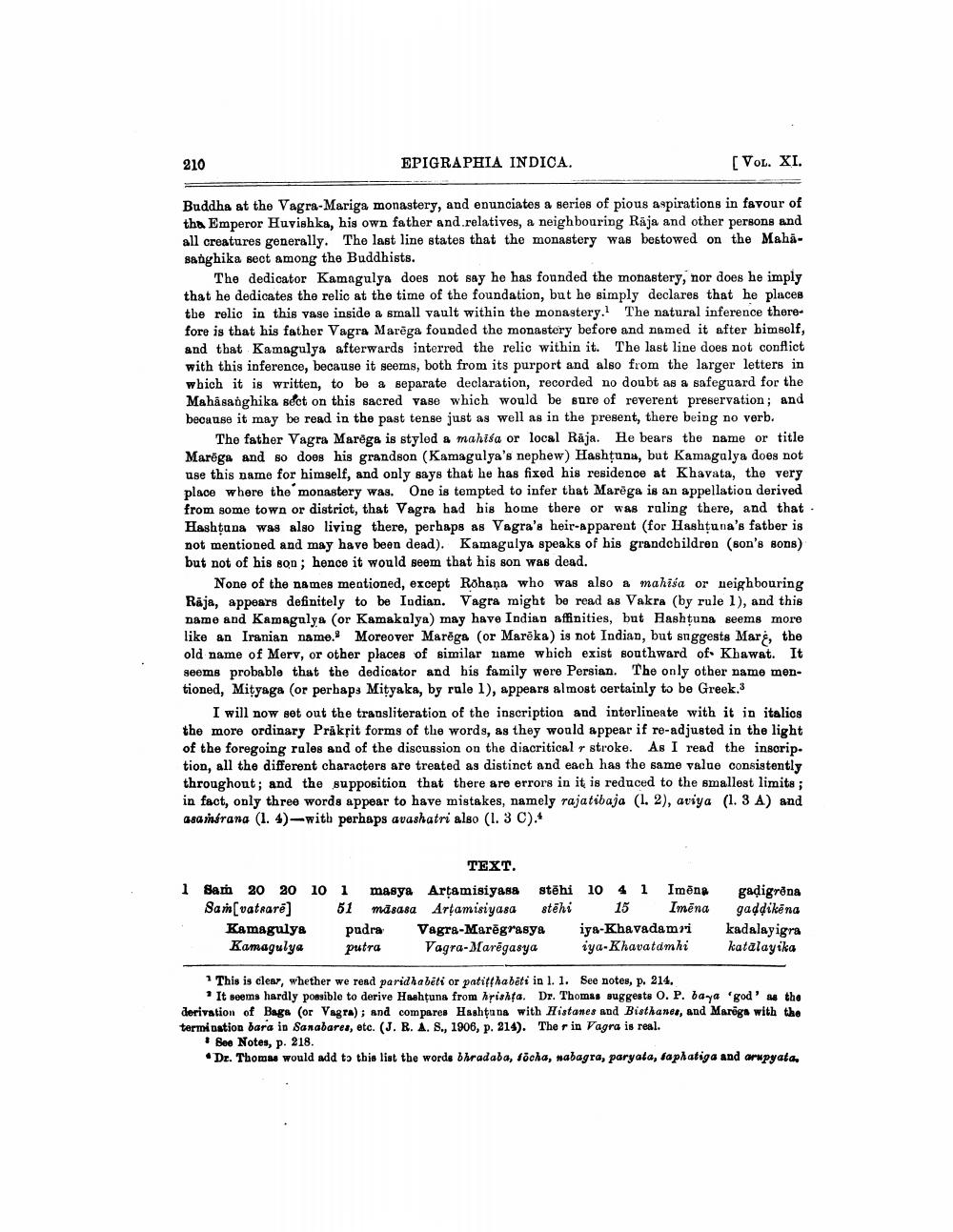________________
210
EPIGRAPHIA INDICA.
[Vol. XI.
Buddha at the Vagra-Mariga monastery, and enunciates a series of pious aspirations in favour of the Emperor Huvishka, his own father and relatives, a neighbouring Raja and other persons and all creatures generally. The last line states that the monastery was bestowed on the MahaBanghika soct among the Buddhists.
The dedicator Kamagulya does not say he has founded the monastery, nor does he imply that he dedicates the relic at the time of the foundation, but he simply declares that he places the relic in this vase inside a small vault within the monastery. The natural inference therefore is that his father Vagra Marēga founded the monastery before and named it after bimself, and that Kamagulya afterwards interred the relic within it. The last line does not conflict with this inference, because it seems, both from its purport and also from the larger letters in which it is written, to be a separate declaration, recorded no doubt as a safeguard for the Mahasanghika séct on this sacred vase which would be sure of reverent preservation; and because it may be read in the past tense just as well as in the present, there being no verb.
The father Vagra Marega is styled & mahiếa or local Raja. He bears the name or title Marēga and so does his grandson (Kamagulya's nephew) Hashtuna, but Kamagalya does not use this name for himself, and only says that he has fixed his residence at Khavata, the very place where the monastery was. One is tempted to infer that Marēga is an appellation derived from some town or district, that Vagra had his home there or was ruling there, and that Hashtana was also living there, perhaps as Vagra's heir-apparent (for Hashtuna's fatber is not mentioned and may have been dead). Kamagulya speaks of his grandchildren (son's sons) but not of his son; hence it would seem that his son was dead.
None of the names mentioned, except Rohana who was also a mahisa or neighbouring Rāja, appears definitely to be lodian. Vagra might be read as Vakra (by rule 1), and this name and Kamagulya (or Kamakalya) may have Indian affinities, but Hashtuna seems more like an Iranian name. Moreover Marēga (or Marēka) is not Indian, but suggests Mars, the old name of Merv, or other places of similar name which exist southward of Khawat. It seems probablo that the dedicator and his family were Persian. The only other name mentioned, Mityaga (or perhaps Mityaka, by rule 1), appears almost certainly to be Greek 3
I will now set out the transliteration of the inscription and interlineate with it in italics the more ordinary Pråkpit forms of the words, as they would appear if re-adjusted in the light of the foregoing rales and of the discussion on the diacritical stroke. As I read the inscrip. tion, all the different characters are treated as distinct and each has the same value consistently throughout; and the supposition that there are errors in it is reduced to the smallest limits; in fact, only three words appear to have mistakes, namely rajatibaja (1.2), aviya (1. 3 A) and asambrana (1. 4)—with perhaps avashatri also (1. 3 C).*
TEXT. 1 Sam 20 20 10 1 masya Artamisiyasa stēhi 10 4 1 Imena Sam(vatrarő] 51 masasa Artamisiyasa stēhi 15 Imëna
Kamagulya pudra Vagra-Marēgrasya iya-Khavadamri Kamagulya putra Vagra-Marēgasya iya-Khavatamhi
gadigrēna gaddikēna kadalayigra katalayika
This is clear, whether we read paridhabēti or patit{habēti in l. 1. See notes, p. 214.
It seems hardly possible to derive Hashtuna from hrishta. Dr. Thomas suggests O. P. baya 'god' as the derivation of Bags (or Vagra); and compares Hashtana with Histanes and Bisthands, and Maroga with the termination bara in Sanabares, etc. (J. R. A. S., 1906, p. 214). The r in Vagra is real.
* See Notes, p. 218. • Dr. Thomas would add to this list the words bhradaba, focha, nabagra, paryata, faphatiga and arupyata.




